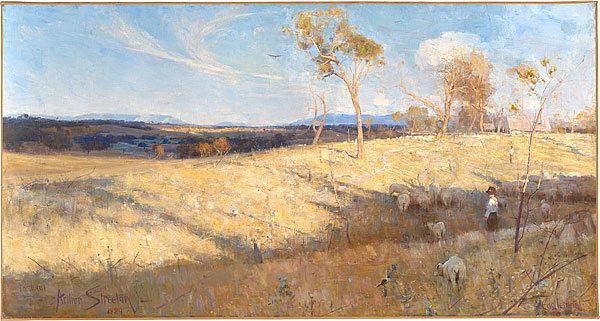Year 1889 Media Paint, Oil paint, Canvas | Medium Oil on canvas Created 1889 | |
 | ||
Dimensions 81.3 cm × 152.6 cm (32.01 in × 60.08 in in) Similar A holiday at Mentone, Shearing the Rams, The Pioneer, In a corner on the Macintyre, A break away! | ||
24 61325 arthur streeton golden summer eaglemont 1889
Golden Summer, Eaglemont is an 1889 painting by Australian artist Arthur Streeton. Painted during a summer drought when Streeton was twenty-one years old, it is an idyllic depiction of sunlit, undulating plains in rural Heidelberg on Melbourne's outskirts. Naturalistic yet poetic, and a conscious effort by Streeton to create his most epic work yet, it is a prime example of the artist's distinctive, high-keyed blue and gold palette, what he considered "nature's scheme of colour in Australia". It is one of his most famous works and is considered a masterpiece of Australian Impressionism.
Contents
- 24 61325 arthur streeton golden summer eaglemont 1889
- Background
- Critical reaction
- Provenance
- References
Background
It was painted en plein air at an artists' camp established by Streeton at Mount Eagle (now Eaglemont), where he and other Australian Impressionists occupied an old weatherboard house. Streeton described the location in a letter to fellow painter Tom Roberts, which he calls "our hill of gold":
I sit here in the upper circle surrounded by copper and gold, and smile with joy under my fly net as all the light, glory and quivering brightness passes slowly and freely before my eyes. Nothing happier than this. I shout and laugh at my immense wealth, all free and without responsibility. Who could steal this from me? No one.
Critical reaction
It was the first painting by an Australian-born artist to be exhibited at both the Royal Academy in London, in 1890, and the Paris Salon the following year, where it won an award. One critic noted the popularity of Golden Summer, Eaglemont with "the crowds that throng the Salon", saying that it was "simply impossible" to pass by the painting "as it is utterly different from any other picture in the vast collection".
Provenance
It was acquired by Scottish shipbuilder Charles Mitchell and remained part of his estate for several years until Streeton bought the painting back.
Ahead of its auction in Australia in 1924, Lionel Lindsay extolled the work in the hope that it would enter a public gallery:
This tranquil landscape, so simply yet so exquisitely fashioned, possesses for Australians a sentiment no other people may equally enjoy. It is the first great Australian landscape, untrammeled by picture making formula, to come from the hand of the native born. It is, therefore, historically the most important landscape in Australia.
It was acquired by a private collector for 1,000 guineas, then a record for a painting by an Australian artist. It broke the same record in 1995 when it was purchased by the National Gallery of Australia for $3.5 million.
